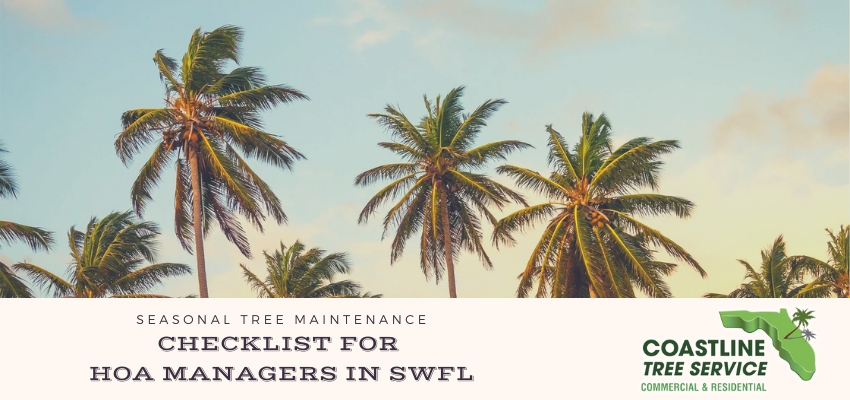
Seasonal Tree Maintenance Checklist for HOA Managers in Southwest Florida
While Southwest Florida may not experience the deep frosts of northern states, the cooler months still bring changes that significantly impact tree care. As HOA managers, maintaining vibrant and healthy tree landscapes is essential for both curb appeal and the health of the environment. With the right approach to seasonal maintenance, you can ensure that your community’s trees thrive year-round. Here is a comprehensive checklist to guide you through tree care during the cooler winter-like weather in Southwest Florida.
Why Seasonal Tree Maintenance Matters in Southwest Florida
Southwest Florida’s subtropical climate creates unique challenges and opportunities for tree maintenance. While our “winter” doesn’t bring snow, the reduced rainfall, cooler temperatures, and drier air can stress trees if they aren’t properly maintained. These seasonal changes make it the ideal time for tasks like pruning, mulching, and adjusting irrigation schedules. Proactive care during these months sets the stage for strong growth during the warmer, rainy season.
Winter Checklist for Healthy Tree Landscapes
1. Inspect Trees for Damage or Weakness
- Walk through the property and evaluate all trees for broken, dead, or diseased limbs. High winds from occasional cold fronts can turn weak branches into hazards.
- Look closely at bark and roots for signs of disease, pests, or decay.
- If you notice structural issues or major damage, contact a professional arborist to assess and manage the situation safely.
2. Prune Without Stressing the Trees
- Cooler months in Southwest Florida are ideal for pruning as trees are less active in their growth periods.
- Trim away dead, diseased, or overcrowded branches to improve tree health and air circulation.
- Ensure the tree’s natural shape is preserved to maintain its aesthetic value and stability.
- Avoid heavy pruning, especially for younger trees, as it can leave them vulnerable.
3. Refresh Mulch Around Trees
- Apply a 2-3 inch layer of mulch around the base of your trees, leaving a small gap around the trunk to prevent rot.
- Mulch helps retain soil moisture, regulate temperatures, and reduce weed growth.
- Use organic mulch, as it breaks down over time, enriching the soil with nutrients.
4. Adjust Irrigation Systems
- With cooler temperatures and reduced rainfall, overwatering is a common issue during winter months in Florida.
- Reduce the frequency of watering while ensuring deep root hydration. Mature trees typically need watering every 2-3 weeks during the dry season, while younger trees may require more frequent monitoring.
- A slow, deep watering approach allows water to penetrate the soil and reach the root zone effectively.
5. Monitor for Pests and Diseases
- Pests don’t take a break in the cooler months. Keep an eye out for common tree problems in Southwest Florida, such as whiteflies, scales, and fungal infections.
- Scale infestations often show as small lumps on branches, while fungal issues may appear as spots on leaves or areas of discoloration on bark.
- Early detection is key to preventing widespread issues. Consider hiring a pest management professional if you notice signs of trouble.
6. Plan for Palm Tree and Tropical Species Care
- Southwest Florida boasts many palm trees, but these require extra care during the cooler months.
- Remove dead fronds and inflorescences to prevent debris during storms.
- Fertilize palms lightly with a balanced fertilizer to maintain vibrant foliage.
7. Aerate and Fertilize When Necessary
- Aerating compacted soil allows roots to breathe and absorb nutrients more effectively.
- Apply a slow-release fertilizer that aligns with the needs of specific tree types on your property.
- Always test the soil first to determine nutrient deficiencies before fertilizing.
8. Plan Ahead for Hurricane Season
- Begin structural pruning now to prepare trees for the intense weather that summer can bring.
- Pay close attention to larger trees near buildings, pathways, or other high-risk areas to ensure safety.
- Stay proactive by creating a long-term tree health plan with a certified arborist.
9. Remove Leaf Litter and Debris
- Raking up fallen leaves not only keeps your community looking tidy but also helps reduce harboring pests and diseases.
- Leaf litter should be composted or disposed of responsibly to maintain a clean landscape.
10. Schedule Professional Maintenance
- Working with a trusted tree service like Coastline Tree Service ensures your community’s trees are in expert hands.
- Trained arborists can handle risky pruning, diagnose tree health concerns, and offer guidance tailored to your HOA’s specific trees and landscape.
Partner with Coastline Tree Service for Expert Care
Coastline Tree Service understands the unique needs of trees in Southwest Florida. Our team specializes in providing reliable, professional services tailored to HOA managers who want their communities to thrive. From regular pruning to pest control and emergency care, we’re here to help.
By following this winter maintenance checklist, HOA managers can create a strong foundation for healthy and beautiful tree landscapes all year round. Don’t wait until summer storms test the durability of your trees—start now and give them the care they need to flourish.
We proudly serve and offer HOA Tree Services in Naples, Marco Island, Bonita Springs, Estero, Fort Myers, Fort Myers Beach, North Fort Myers, Cape Coral, Sanibel & Punta Gorda.
Contact us today to schedule an assessment or discuss a year-round maintenance program at: (239) 895-3230 or contact us online at: https://www.coastlinetree.com/contact-us/
